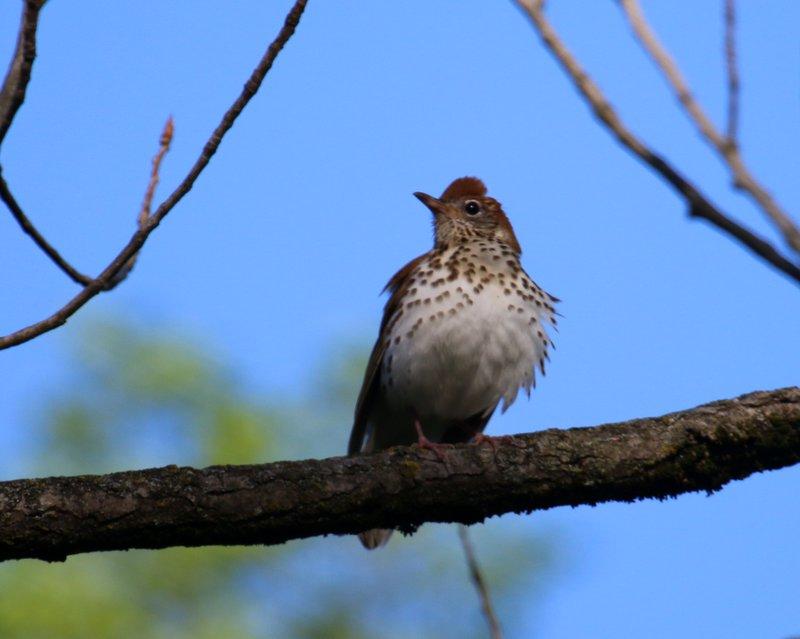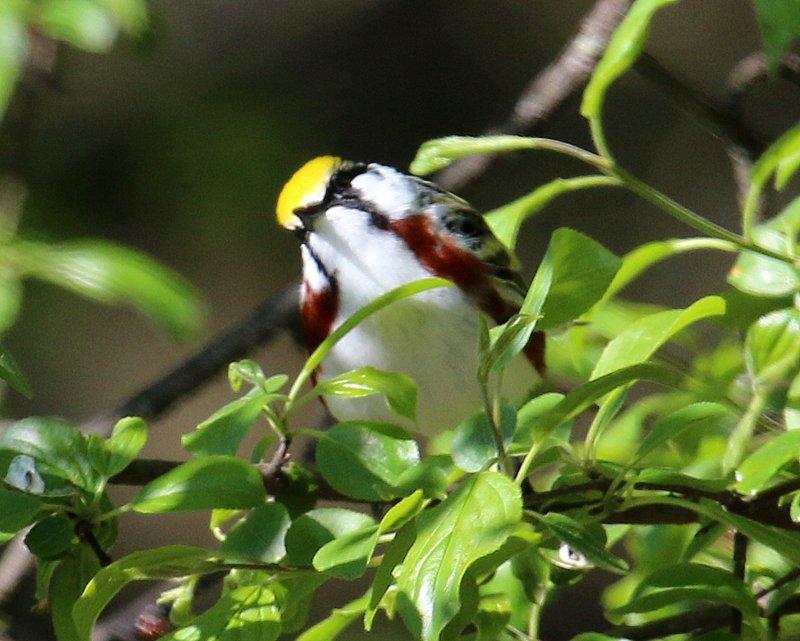The Cornell Lab Bird Academy › Discussion Groups › Joy of Birdwatching › Activities: Noticing Behaviors
-
I watched a robin, it was standing on the ground in the yard singing but did not seem to be foraging for food. There are also sparrows in the yard and several other bird calls beside the robin
-
After about 10 minutes listening different I could identify a blue Jay, chipping sparrow, house wren, and also a morning dove. It was interesting who many different sounds these birds can make.
-
2. At our feeder in winter, the chickadees land at the feeder, pick one sunflower seed, then fly over to the hawthorn tree, hold the seed with their toes, and peck until they get the seed open. The redpolls mostly land on the deck as a group, and hop around, sifting through the sunflower seeds that have been scattered. They eat the seeds while standing on the deck. The hairy woodpecker lands on the feeder and digs thrugh the seeds, scattering sunflowers all over the deck. He finally selects one, then flies back to the aspen trees on the edge of the yard. 3. Today out my window, i here lots of robins and white throated sparrows, and an occasional raven. I hear several other bird calls, but I haven't got them figured out yet. Maybe a chipping sparrow and a yellow rumped warbler?
-
Activity 1 - Today I saw a Hutton's Vireo bathing in the fountain in our backyard. We just learned about cleaning, so the timing was great. The bird started at the top tier of the fountain, which is a very small area, about 10 inches across, with moving water coming into it. He would jump in, shake his feathers, then hop to a nearby branch on a shrub to clean his beak. Now that I know that rubbing the beak on a branch is a form of cleaning, I could see that he was doing a cleaning routine - fountain to branch, then repeat. It took him a while. I read about them on All About Birds, it says they appear in twos which does seem to be the case, because I have seen the other one.
-
Hello everyone. We've enjoyed watching all the birds this Memorial Day weekend. Many different behaviors observed now that I know what to look for. Many different feeding habits for different birds. The Baltimore Orioles love the thick slices of oranges we are providing them. Almost more than the liquid feeder. Amazing how quickly they can extract the juices from the pulp of the oranges with their pointed beaks. Two female turkeys have also become regulars underneath the bird feeders in the last two weeks. They scratch the earth to make sure they get every last seed that falls. We also see a male Cardinal who prefers to show up just at dusk on many evenings. We see him during the day, but much more often in the early evening. The Eastern Bluebirds are my favorites right now. They are busy picking at the ground for bugs. We also started putting out some meal worms and they seem to love them. I have one female bluebird who perches on a shepherds hook by my window and preens herself early each morning. She fluffs and seems to be drying her feathers. This is also one time I can actually get a closer look at the pretty blue feathers under her wings. Northeast Wisconsin.
![20200525_072235[1]](data:image/gif;base64,R0lGODlhAQABAAAAACH5BAEKAAEALAAAAAABAAEAAAICTAEAOw==)
![20200525_073205[1]](data:image/gif;base64,R0lGODlhAQABAAAAACH5BAEKAAEALAAAAAABAAEAAAICTAEAOw==)
-
Activity One - We just put up a feeder here on Long Island, NY, but birds are taking awhile to visit it. There are a couple of "regulars" already though- one a Downy Woodpecker and another that looks like a Finch. The Sparrows seem to prefer to peck at the seed that falls below the feeder. I have had trouble observing bird behavior for any length of time because they birds in our backyard fly away quickly. Activity Two - I enjoy watching the Cornell Bird Cam. I have observed that the Mourning Doves try to be as inconspicuous as possible when they are at the feeder, particularly when the Grackles show up. The Cardinals are similar and stay on nearby branches awhile until it looks like it's safe to be on the feeder. The Woodpeckers however do not seem as cautious, and once on the feeder, they seem pretty comfortable. Activity Three - I can now identify the Blue Jay's call as well as the Robin's song and that of the Black-Capped Chickadee. I often hear the birds singing before sunrise.
-
House Sparrows enjoy dust bathing in the dry, sandy patches of my backyard. I wondered if they might prefer a water bathing area, so I bought a 20" plastic birdbath (the hanging type) but placed it in a raised planter bed instead of suspending it. So far, I have observed only one sparrow using it! So dust bathing must be very effective as a means for cleaning feathers.
-
Activity 3 Noticing behaviors, Listening to birds, I had two song listening experience yesterday. I went to take a daily picture at a pond where Ibis with friends like to gather. As I arrived a flock of 30+ Ibis took off and flew away before I had my camera out of the car. They started to dribble back one at a time, but only 30 feet from me a redwing blackbird landed on some long reeds. He picked a particular reed and shimmied down the reed to someplace near the water and out of my view. I theorized he was either eating or more likely there was a nest down there. His "red wing" had faded so I think it was after the beginning of the breeding season. He chirped a few times to another blackbird without a red wing patch who remained about 15 feet down the shoreline on another reed. They chirped back and forth. Then the unmarked (female?) burst into song. Recently I read that northern birds both males and females sing but southern birds exclusively males sing. As I see the red winged blackbird in MA as well, along with cardinals and blue jays quite regularly, I guess the rule is not hard and fast or maybe applies to only the species that don't change or span large ranges of latitudes. The male and female are shown below.

 Later in the day I was listening on my lanai and I head a sound like the end of the northern cardinal (who seems to live year rounding southwest Florida). The song was moving slowly from my right to my left. I finally caught sight of the cardinal quite low in the trees and shrubs. It was definitely a male cardinal. I didn't get his photo but have included one of my favorites from last year pretty close to the same place and time in 2019.
Later in the day I was listening on my lanai and I head a sound like the end of the northern cardinal (who seems to live year rounding southwest Florida). The song was moving slowly from my right to my left. I finally caught sight of the cardinal quite low in the trees and shrubs. It was definitely a male cardinal. I didn't get his photo but have included one of my favorites from last year pretty close to the same place and time in 2019. I guess this guy just likes the last half of his song. He didn't do the first two long notes, just started in the middle doing the staccato notes. I had thought the ever so noisy mockingbirds were the ones doing partials on the cardinal song but by paying attention for the course I found I was wrong.
I guess this guy just likes the last half of his song. He didn't do the first two long notes, just started in the middle doing the staccato notes. I had thought the ever so noisy mockingbirds were the ones doing partials on the cardinal song but by paying attention for the course I found I was wrong. -
I like your story about the Red-winged Blackbirds. I see them a lot in the cat tails around a small lake I walk by every day.
-
Red-winged blackbirds are very common in my area (Island of Montreal), but I've never seen one with so much orange on the wings (your first photo): maybe regional, or just the way the wings fluffed? Catherine
-
-
Went on a nature walk and saw several birds and heard several birds. Birds we saw were: Yellow-rumped warbler, Blue-headed vireo, Dark-eyed Junco, Chipping Sparrows, Mallards, and geese. Birds we heard were: Wood Thrush, Robins, Yellow Warblers, Pileated Woodpecker, Morning Doves, Cardinals, Black-throated Green Warbler, White-breasted Nuthatch, Blue Jays, Wood Duck, and a Black-capped Chickadee. It was pretty awesome to see so many birds and hearing all the different birds was amazing also.
-
Several ruby throated hummingbirds have been active at my feeders however despite the multitude of flowers I have provided, all of which are hummingbirds' favorites, they seem to prefer the feeders. Having researched this behavior it seems that it should be the opposite as flowers should be the preferred food. So I am not sure why this seems to be the case.
-
I tuned in to the Cornell Lab Feeder Cam and dropped into a bird party! Common Grackles, one Blue Jay, one Red-Winged Blackbird, a Red-Bellied Woodpecker, male and female Northern Cardinal, a couple European Starlings, a Mourning Dove, and a little guy I couldn't ID. It was interesting to see how the woodpecker seemed to prefer of hanging under the feeder, and how it seemed to prefer some feeders over the others. The woodpecker also showed some aggressive postures toward birds that came too close. The others were chill about sharing space. Oh, now everyone is gone and a squirrel is just sitting in the feeder lol
-
It's amazing what you can hear and see in just 5 minutes. A total of 14 species, including red-winged black birds, northern cardinals, and red-tailed hawks.
-
I just set up some feeders and added one for orioles. After 3 days a male Hooded Oriole found it. It has come back the last few days and lands on the top of the pole and calls, then flies down to feed. Today after he did this he was joined by a female.
-
I've been seeing a fair amount of Anna's Hummingbirds in our neighborhood. This morning I was able to observe one perched on a branch from some english ivy. She was cleaning her beak on the branch! She then flew off out of sight and came back a couple of minute later to shake her feathers and clean her beak some more. It looks like we both had some pretty satisfying showers this morning.
-
Activities Observing Behavior. Activity 1 and 2 were spent looking at the Sapsucker woods bird cam. Most of the birds seemed to be on pretty good behavior. Some like the blue jays seemed to be one at a time visitors. Others like the boat tailed grackles seemed to come in bunches. The Baltimore Orioles, and Cardinals and Doves were often in pairs. The only birds eating fruit were the Baltimore Orioles and the Robin. There were mostly middle sized birds there, no Crows or bigger birds and I saw only one smaller Tufted Titmouse and one Nuthatch. Most of the birds seemed to be focused on feeding. The grackles seemed to have a tendency to look up quite often. They were in the largest numbers today and seemed to be looking up a lot. Most other birds seemed to be looking more at the seeds. The Downey and Red Bellied Woodpeckers all fed on vertical feeders. Just as they are mostly observed hunting and digging on the side of trees , Activity 3 sounds in the background: The honking of Canada Geese and several other background trill calls were there in the background. I am not familiar with Birds on the feeder were very quiet..
-
[1] The only behaviour that I found to be unusual -- and unnoticed until this course -- is the backwards scratching at the ground of certain sparrows. I still find this fascinating to watch. No other of my birds seems to do this. [2] I have noticed that my black-capped chickadees, much like a great many small birds, take one seed at a time. Sometimes they fly away with the seed, smack it open, eat it, and then return for another. Other times, they sit right at the feeder and eat the seed. Even when there is nyjer on the ground, they seem to prefer to cling to a tube-feeder and eat directly from it. The dark-eyed juncos, on the other hand, seem to eat exclusively on the ground. [3] I have been working on learning to identify bird songs since taking that course in January. I am getting much better at it but still have a long way to go. The song that I lost recently learned is that of the House Wren, which sounds rather like being scolded. I have been trying to learn to distinguish the different chips of various woodpeckers. This will take me some time but I seem to have a great deal of time on my hands these days.
-
1. Watching an American Robin in my backyard (Westchester County, NY). I feel that they have a distinct stride or hop and spend so much more time on the ground then other "backyard birds". I understand that part of the reason may be the type of food they search out. Watching a green heron today (which is not all that common in my area at this time of year) he was sitting pretty high up in a tree. He was preening himself for quite some time. I noticed that he also dips his head, almost completely underneath himself- perhaps this is telltale of a heron. I have seen the night heron make this move as well. Earlier today I also saw two adult Canada geese and their 3 goslings. The parents are very attune, understandably, to where the babies are at all times. One seems to be look-out while the other keeps eye on the kids. The goslings were so sweet and followed what mom and dad were doing- dunking in the water-looking for things to eat.


 Birds really do have unique ways of eating, what they eat and how they approach food. The red-bellied woodpecker in my yard tends to come in for one piece of food and then fly a short distance to the nearest tree. He will repeat this numerous times. On occasion he will stay for a second bite- it usually depends on if it is seed or suet. I have also seen him take nuts and find hiding places for them. The woody and hairy woodpeckers seem to be more comfortable spending more time at the feeder. Working to get more a meal or multiple bites in one visit. I love watching the doves feed. They will come to me deck when I sprinkle seed and spend some time in one area while they feed as long as they are not disturbed. They also seem willing to have others (birds) around when they are eating. The starlings seem to drive lots of other birds away because they are very dramatic (chaotic). They flap their wings a great deal and "yell" at one another. They seem to give each other a hard time at the feeders and rarely let another near.
3. I am slowly starting to be able to recognize a few different birds by their songs or calls. I am amazed at how many different sounds some of them have. I imagine they mean different things to those who know them. I heard a gray catbird up close for the first time and it really did sound like a meow. However, later in the day I heard a different one and it sounded very different. I have a long way to go.
Birds really do have unique ways of eating, what they eat and how they approach food. The red-bellied woodpecker in my yard tends to come in for one piece of food and then fly a short distance to the nearest tree. He will repeat this numerous times. On occasion he will stay for a second bite- it usually depends on if it is seed or suet. I have also seen him take nuts and find hiding places for them. The woody and hairy woodpeckers seem to be more comfortable spending more time at the feeder. Working to get more a meal or multiple bites in one visit. I love watching the doves feed. They will come to me deck when I sprinkle seed and spend some time in one area while they feed as long as they are not disturbed. They also seem willing to have others (birds) around when they are eating. The starlings seem to drive lots of other birds away because they are very dramatic (chaotic). They flap their wings a great deal and "yell" at one another. They seem to give each other a hard time at the feeders and rarely let another near.
3. I am slowly starting to be able to recognize a few different birds by their songs or calls. I am amazed at how many different sounds some of them have. I imagine they mean different things to those who know them. I heard a gray catbird up close for the first time and it really did sound like a meow. However, later in the day I heard a different one and it sounded very different. I have a long way to go. -
1. Watching an American Crow: He waddles and searches my yard looking for nuts that were buried by squirrels. When he finds one, he chips at it till he gets it. Sometimes, he'll fly to the birdbath and put the food in the water, waits a few seconds and scoops it up to swallow it. He is definitely less afraid of people and will allow me to get much closer to him that other birds. He "caws" a LOT and sticks his neck out each time. He probably broods in a huge evergreen tree across the street. They fight and fly around incessantly. 2. The House Sparrow stays put at the feeder for much longer than any other birds that visit. He seems pretty unafraid. He also chases off other birds. Right now, I have a nest right next to the right side bird feeder. This feeder is generally the most popular, due to a lavender bush situated next to it. It always empties first. Now however, it is nearly still full after 3 weeks due to the fact that the mama sparrow chases off the other birds. They have to attempt to use the left feeder if she lets them. The chickadee comes and goes quite quickly; flies to a branch and eats there. But the redbreasted nuthatch comes and goes the quickest. A speedy entrance and a quick grab - away it goes. It never eats at the feeder nor does it eat in a nearby bush or tree. 3. If I'm in the woods, the bird that I usually hear the most is the Swainson's Thrush- my favorite song of all. I've never spotted it however. I also hear the Robin and the woodpecker, sparrows and chickadees. I LOVE the Chickadee's two-noted song during mating season. It's a minor interval and totally fascinating to me. Also, I can sometimes hear the nuthatch's little horn like, monotone song, which even though it's not very exciting, I still find very fun to listen to.
-
 I was in the Galapagos on March 12 of this year. These are Blue Footed Boobies doing a mating dance. There were lots of vocalizations which I got on video. Truly an amazing experience and in the time of COVID I am so thankful I squeaked that one it.
I was in the Galapagos on March 12 of this year. These are Blue Footed Boobies doing a mating dance. There were lots of vocalizations which I got on video. Truly an amazing experience and in the time of COVID I am so thankful I squeaked that one it.
-
I am fortunate, in this time of COVID, to live on a property that has multiple habitats. I live on the river, and have both a large clearing and a wooded area. At the river, we see numerous Eastern Phoebe, Red Winged Blackbirds, Heron, and an very special Bald Eagle. In the plain grass, we have Robins, Grackle, Brown headed cowbirds and starlings, In the wooded brush, we have multiple types of sparrow, Eastern Bluebirds, and purple and golden finches. Throughout it all, we have so many woodpeckers: Red bellied, Downy, Hairy, Piliated, and Northern Flicker.We have one lone red headed woodpecker (see an awful picture of this striking bird) It has been fun to watch my more common birds more closely, and I am grateful for this lesson in teaching so many valuable things. I have seen: two Robins fighting over territory, Red wing B
 Blackbirds puff up their colors around other birds, and Starlings, Grackle, Robins, and Brown Headed Cowbirds all eating peacefully together.
Blackbirds puff up their colors around other birds, and Starlings, Grackle, Robins, and Brown Headed Cowbirds all eating peacefully together. -
 Activity 1: We watched the Ring-billed Gulls in action alongside our area's large lake. The Merlin app really helps to differentiate on the spot but the All About Birds website review certainly makes one a local expert. The flying, wading, behaviors we've noted for years take on new meaning with this birding course. We live in a breeding area for these gulls so they are everywhere. Unfortunately they draw tourists who feed them anything and everything which always brings on a flock. / Activity 2: We seem to watch the squirrels try every antic they know to acquire seeds from our "squirrel proof" bird feeder but watching birds for 15 minutes will be our challenge going forward. We'll have to add more feeders to attract an array of birds that stay awhile. / Activity 3: Recognizing bird songs will also take more practice ---made more fun with the games at the Cornell Ornithology website. The dawn chorus is a little early for us!
Activity 1: We watched the Ring-billed Gulls in action alongside our area's large lake. The Merlin app really helps to differentiate on the spot but the All About Birds website review certainly makes one a local expert. The flying, wading, behaviors we've noted for years take on new meaning with this birding course. We live in a breeding area for these gulls so they are everywhere. Unfortunately they draw tourists who feed them anything and everything which always brings on a flock. / Activity 2: We seem to watch the squirrels try every antic they know to acquire seeds from our "squirrel proof" bird feeder but watching birds for 15 minutes will be our challenge going forward. We'll have to add more feeders to attract an array of birds that stay awhile. / Activity 3: Recognizing bird songs will also take more practice ---made more fun with the games at the Cornell Ornithology website. The dawn chorus is a little early for us! -
Activity 1: We have noticed a lot of Blue-gray Gnatcatchers on our walks lately. They are so difficult to photograph because they constantly moving about eating insects. Activity 2: We have a lot of different birds that come to our bird feeders and each species does seem to have its own style. The Downy Woodpecker always goes to the suet and is not shy about sticking around; the Red-bellied Woodpecker and Blue Jays take a peanut and leave to eat it on our maple tree; the European Starlings, our least favorite birds, come in a flock, crowd out the other birds, and make a mess by spilling the bird seed all over the patio. Activity 3: We are beginning to notice a few more bird songs than before. We can identify the Cardinals, Blue Jays and Gray Catbirds immediately. We were treated to a wonderful song by a Wood Thrush recently.



-
Activity 2: The Northern Cardinals at my feeders will park themselves at my feeders and eat seeds there typically. They'll stay for long periods at a time if not disturbed. I also spotted some courtship behavior the other day in which the male cardinal was feeding a female. The Carolina Chickadees are more likely to hop on the feeder for a moment, grab a seed, and fly off again and then repeat. Same thing with my Tufted Titmice - they'll take a seed and eat it elsewhere. The doves are usually on the ground by the feeder and will graze there, though I did see one on my feeder today! Like the cardinals, the doves tend to stick around for a while as long as they aren't bothered. There is a red-bellied woodpecker who also enjoys our bird feeder. It will stop and eat seeds for about half a minute before flying off again into the trees. I saw a brown thrasher trying somewhat successfully to get some suet from our woodpecker suet feeder. It balanced awkwardly but managed to get a little before giving up and going elsewhere. Our crows do the same thing. They peck a little at the suet feeder, but as it's not built with them in mind, they don't spend too much time on it.
-
Activity 1: I was watching a House Finch sitting on top of a pole. He was mostly looking around. He fluffed up once and did a little bill-wiping, but not much other than that. I'm guessing that he was mostly just keeping an eye out for predators and his kind. Activity 2:I heard the songs of the American Robin, European Starling, House Finch, and Eurasian Collared Dove. I'm learning that birding is just as much about sound as it is about sight.
-
1. Sulphur Crested Cockatoos have been landing in a tree over our pool late in the morning and staying much of the day. They are eating the seeds off the tree by biting off the tips of branches, holding them with their feet and picking off the seeds. The branches land in our pool. There are many birds in the valley behind our home and periodically a cockatoo will give off a scare call and the cockatoos in the tree will join others forming a large squawking flock that circles the valley with other species joking them for part of the action. Eventually they will settle again. 2. The Cockatoos in our tree (eucalyptus) snap the tips off branches, pick off seeds with their beak and crack a seed open. they discard the outer part of the seed. 3. Noisy minors, Lorikeets, King Parrots, Magpies, Currawong.
Read More:
![20200525_072235[1]](https://academy.allaboutbirds.org/wp-content/uploads/hm_bbpui/705027/T0pyfs8qzep6crzhhb1dcickvz1n40xak.jpg)
![20200525_073205[1]](https://academy.allaboutbirds.org/wp-content/uploads/hm_bbpui/705027/Timo6xc764kk9shxw1oayieov45c35hta.jpg)
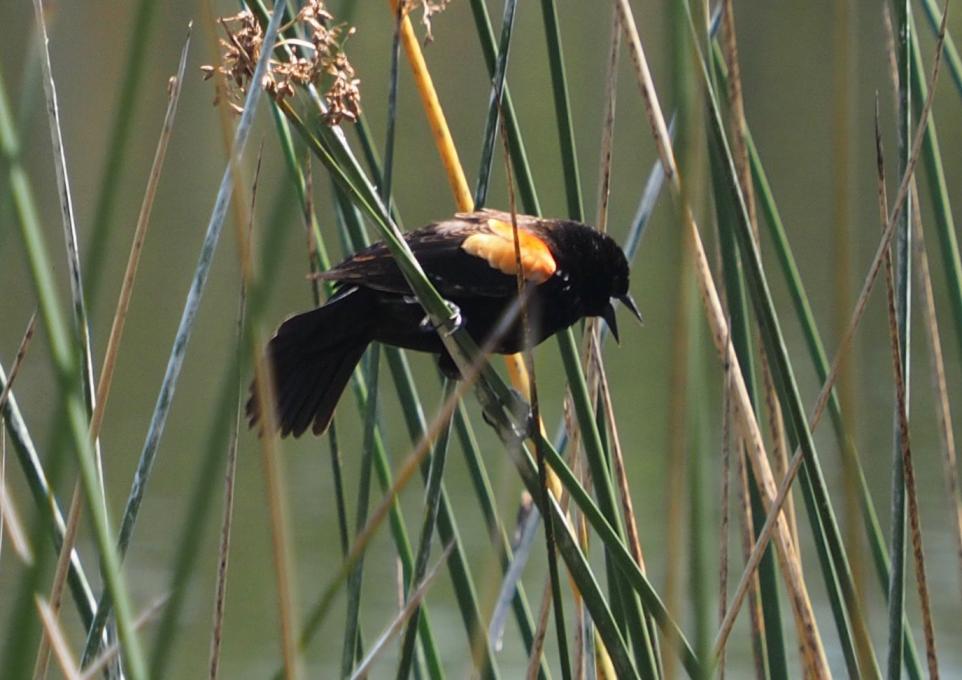
 Later in the day I was listening on my lanai and I head a sound like the end of the northern cardinal (who seems to live year rounding southwest Florida). The song was moving slowly from my right to my left. I finally caught sight of the cardinal quite low in the trees and shrubs. It was definitely a male cardinal. I didn't get his photo but have included one of my favorites from last year pretty close to the same place and time in 2019.
Later in the day I was listening on my lanai and I head a sound like the end of the northern cardinal (who seems to live year rounding southwest Florida). The song was moving slowly from my right to my left. I finally caught sight of the cardinal quite low in the trees and shrubs. It was definitely a male cardinal. I didn't get his photo but have included one of my favorites from last year pretty close to the same place and time in 2019. I guess this guy just likes the last half of his song. He didn't do the first two long notes, just started in the middle doing the staccato notes. I had thought the ever so noisy mockingbirds were the ones doing partials on the cardinal song but by paying attention for the course I found I was wrong.
I guess this guy just likes the last half of his song. He didn't do the first two long notes, just started in the middle doing the staccato notes. I had thought the ever so noisy mockingbirds were the ones doing partials on the cardinal song but by paying attention for the course I found I was wrong. 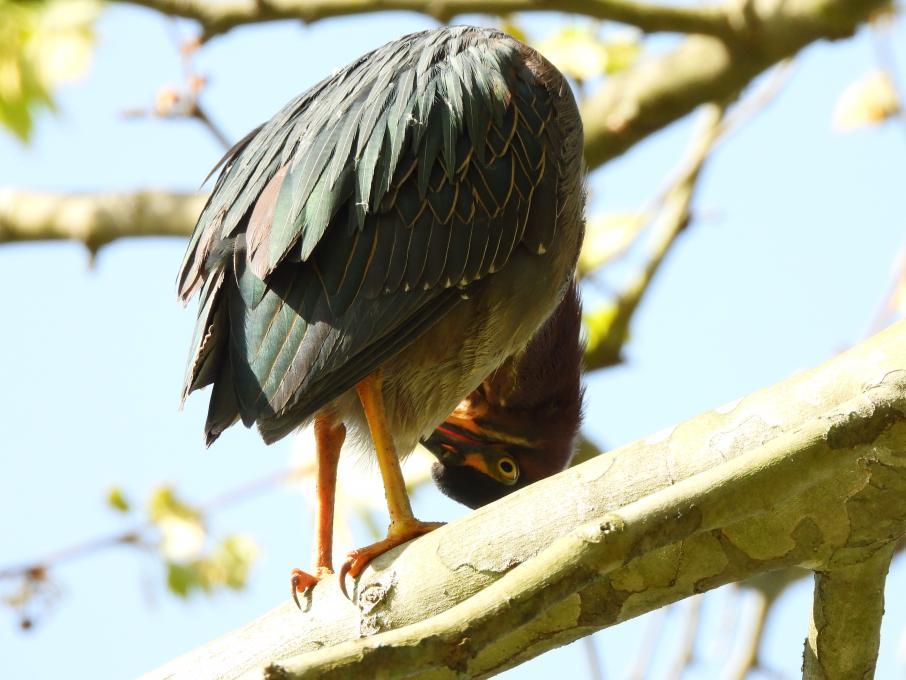
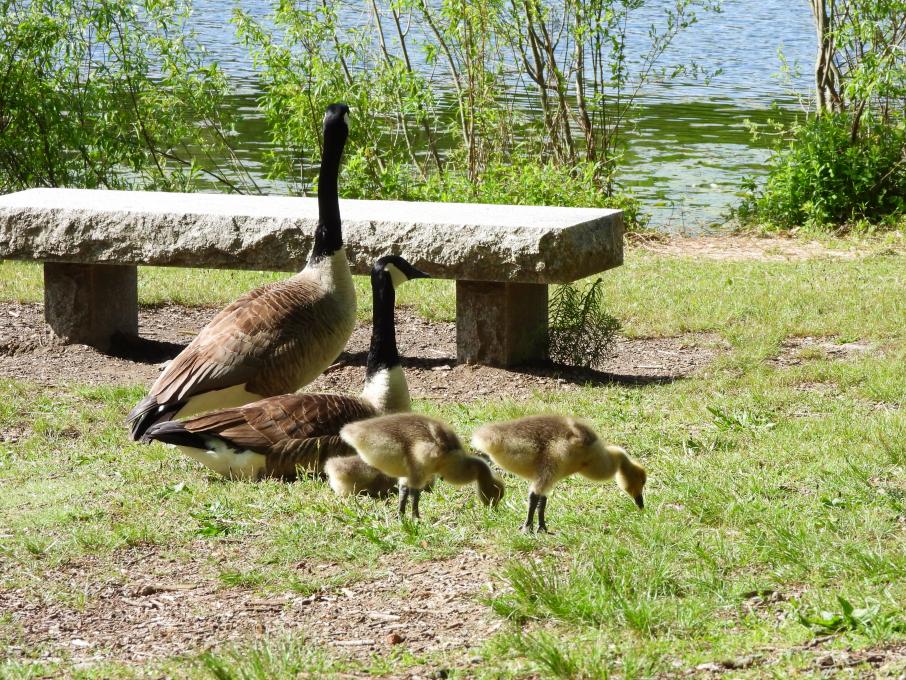
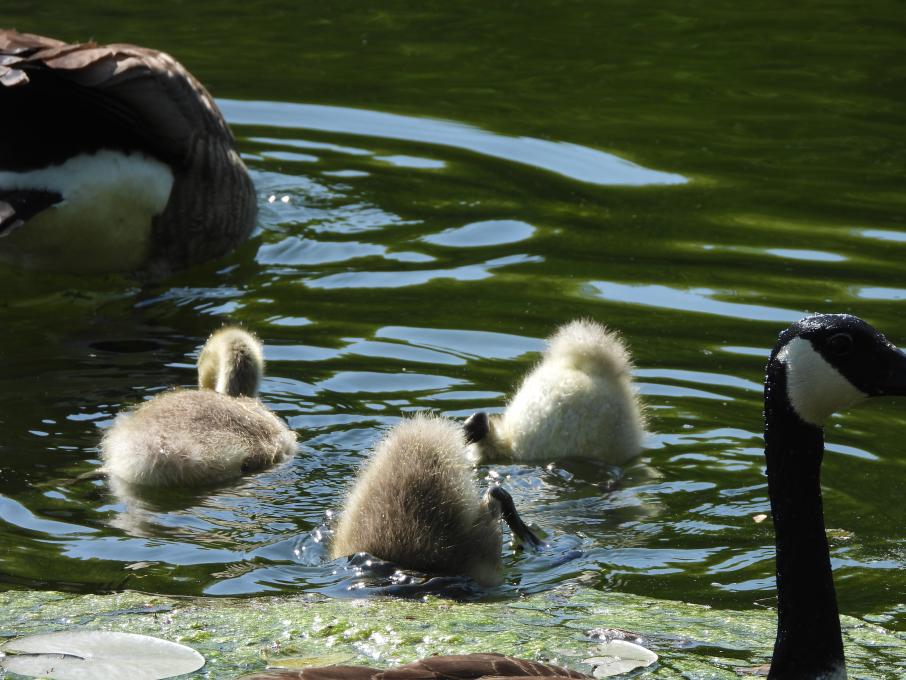 Birds really do have unique ways of eating, what they eat and how they approach food. The red-bellied woodpecker in my yard tends to come in for one piece of food and then fly a short distance to the nearest tree. He will repeat this numerous times. On occasion he will stay for a second bite- it usually depends on if it is seed or suet. I have also seen him take nuts and find hiding places for them. The woody and hairy woodpeckers seem to be more comfortable spending more time at the feeder. Working to get more a meal or multiple bites in one visit. I love watching the doves feed. They will come to me deck when I sprinkle seed and spend some time in one area while they feed as long as they are not disturbed. They also seem willing to have others (birds) around when they are eating. The starlings seem to drive lots of other birds away because they are very dramatic (chaotic). They flap their wings a great deal and "yell" at one another. They seem to give each other a hard time at the feeders and rarely let another near.
3. I am slowly starting to be able to recognize a few different birds by their songs or calls. I am amazed at how many different sounds some of them have. I imagine they mean different things to those who know them. I heard a gray catbird up close for the first time and it really did sound like a meow. However, later in the day I heard a different one and it sounded very different. I have a long way to go.
Birds really do have unique ways of eating, what they eat and how they approach food. The red-bellied woodpecker in my yard tends to come in for one piece of food and then fly a short distance to the nearest tree. He will repeat this numerous times. On occasion he will stay for a second bite- it usually depends on if it is seed or suet. I have also seen him take nuts and find hiding places for them. The woody and hairy woodpeckers seem to be more comfortable spending more time at the feeder. Working to get more a meal or multiple bites in one visit. I love watching the doves feed. They will come to me deck when I sprinkle seed and spend some time in one area while they feed as long as they are not disturbed. They also seem willing to have others (birds) around when they are eating. The starlings seem to drive lots of other birds away because they are very dramatic (chaotic). They flap their wings a great deal and "yell" at one another. They seem to give each other a hard time at the feeders and rarely let another near.
3. I am slowly starting to be able to recognize a few different birds by their songs or calls. I am amazed at how many different sounds some of them have. I imagine they mean different things to those who know them. I heard a gray catbird up close for the first time and it really did sound like a meow. However, later in the day I heard a different one and it sounded very different. I have a long way to go.  I was in the Galapagos on March 12 of this year. These are Blue Footed Boobies doing a mating dance. There were lots of vocalizations which I got on video. Truly an amazing experience and in the time of COVID I am so thankful I squeaked that one it.
I was in the Galapagos on March 12 of this year. These are Blue Footed Boobies doing a mating dance. There were lots of vocalizations which I got on video. Truly an amazing experience and in the time of COVID I am so thankful I squeaked that one it.
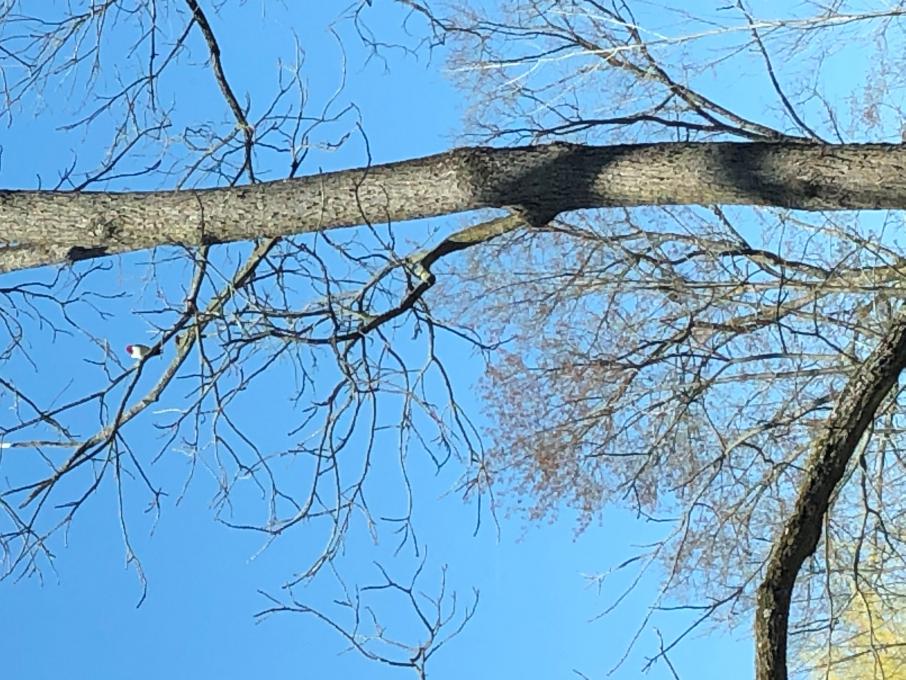 Blackbirds puff up their colors around other birds, and Starlings, Grackle, Robins, and Brown Headed Cowbirds all eating peacefully together.
Blackbirds puff up their colors around other birds, and Starlings, Grackle, Robins, and Brown Headed Cowbirds all eating peacefully together.  Activity 1: We watched the Ring-billed Gulls in action alongside our area's large lake. The Merlin app really helps to differentiate on the spot but the All About Birds website review certainly makes one a local expert. The flying, wading, behaviors we've noted for years take on new meaning with this birding course. We live in a breeding area for these gulls so they are everywhere. Unfortunately they draw tourists who feed them anything and everything which always brings on a flock. / Activity 2: We seem to watch the squirrels try every antic they know to acquire seeds from our "squirrel proof" bird feeder but watching birds for 15 minutes will be our challenge going forward. We'll have to add more feeders to attract an array of birds that stay awhile. / Activity 3: Recognizing bird songs will also take more practice ---made more fun with the games at the Cornell Ornithology website. The dawn chorus is a little early for us!
Activity 1: We watched the Ring-billed Gulls in action alongside our area's large lake. The Merlin app really helps to differentiate on the spot but the All About Birds website review certainly makes one a local expert. The flying, wading, behaviors we've noted for years take on new meaning with this birding course. We live in a breeding area for these gulls so they are everywhere. Unfortunately they draw tourists who feed them anything and everything which always brings on a flock. / Activity 2: We seem to watch the squirrels try every antic they know to acquire seeds from our "squirrel proof" bird feeder but watching birds for 15 minutes will be our challenge going forward. We'll have to add more feeders to attract an array of birds that stay awhile. / Activity 3: Recognizing bird songs will also take more practice ---made more fun with the games at the Cornell Ornithology website. The dawn chorus is a little early for us! 